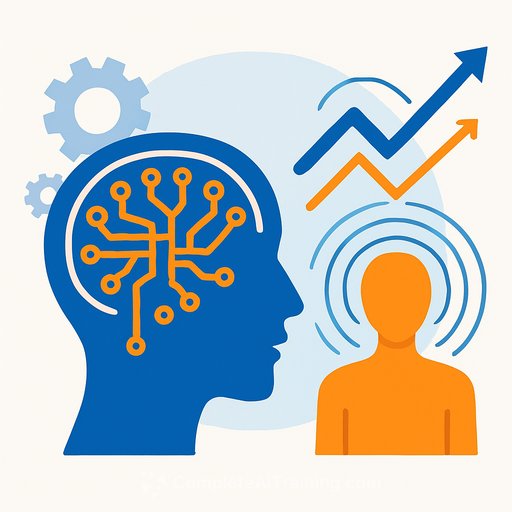AI Singularity Timelines: What Scientists and Research Leaders Should Track Now
For 300,000 years, Homo sapiens sat uncontested at the top of the intelligence chart. With modern AI, that position is no longer guaranteed. A growing share of experts now treat the singularity-not as a question of if-but when.
A recent synthesis by AIMultiple combined 8,590 predictions from scientists and entrepreneurs. The dates keep moving earlier as AI systems clear milestones faster than expected. Leaders in the field now put serious probability mass on this decade.
What "singularity" means in this context
In math and physics, a singularity is a breakdown in known laws. In technology, the term-popularized by Vernor Vinge and Ray Kurzweil-refers to the point where machine intelligence accelerates beyond human control. Many take this to mean an AI more capable than humanity as a whole.
Analysts often include traits like human-level reasoning, superhuman speed, near-perfect recall, and possibly machine consciousness. The last point is contested because consciousness lacks a precise definition.
Where expert timelines stand
- Earliest predictions: 2026
- Investor median: ~2030
- Consensus range: 2040-2050
- Pre-ChatGPT views: often 2060 or later
Since 2022, capability jumps have pulled timelines forward. The core driver: model scaling and efficiency improvements that many did not forecast at this pace.
The aggressive cases
Dario Amodei (Anthropic) has argued we could see systems with Nobel-level competence across key fields as early as 2026, operating 10-100x faster than people. Elon Musk has said AGI could appear within one to two years. Sam Altman has suggested "a few thousand days," implying late 2020s into early 2030s.
These claims are bold, but they rest on observed compounding improvements in training compute, model quality, data pipelines, and deployment scale.
Why timelines pulled forward
Generative models outperformed expectations on reasoning, coding, and tool use. Training compute for frontier models has roughly doubled on a months-long cadence, and better algorithms squeeze more capability from the same budget. If scaling accelerates, a capability cascade could follow.
That said, AI has a history of over-promising. Geoffrey Hinton once forecast AI would replace radiologists by 2021. In 1965, Herbert Simon claimed machines would do any human job within 20 years. Current systems still fall short on general causal reasoning, grounded understanding, and autonomous long-horizon planning in the physical world.
AGI as a waypoint
Artificial General Intelligence (AGI) is the point where a system matches human performance across a wide range of tasks-not just a single domain. After AGI, many expect "superintelligence" within 2-30 years via self-improvement and scaled training.
Across multiple surveys, experts cluster around AGI by ~2040, with investors skewing earlier near ~2030. From there, several polls assign a meaningful chance the singularity follows within decades.
The safety and governance lens
Elon Musk and the late Stephen Hawking have warned about existential risks if unaligned systems gain open-ended capabilities. The concern is not sentience; it's competence, speed, and the ability to act in the world with objectives that conflict with human goals.
Balancing acceleration with safety research, testing, and governance is not optional if short timelines prove correct.
Practical signals to watch
- Generalization across tasks: Consistent gains on broad benchmarks (e.g., scientific QA, code, math) without heavy prompt tricks.
- Long-horizon autonomy: Reliable multi-step planning with tool use, memory, and recovery from errors across domains.
- Sample efficiency: Human-level performance with far less data or via self-play/self-curriculum.
- World models: Improved causal reasoning, counterfactuals, and physical reasoning; fewer hallucinations under pressure.
- Real-world robotics: Transfer from simulation to reality with low data and robust manipulation in unstructured settings.
- Self-improvement: Systems that write, test, and verify their own code, research plans, and training pipelines end-to-end.
- Safety under stress: Alignment that holds under new tools, hidden prompts, or high-stakes incentives.
- Compute and efficiency: Faster capability growth per dollar of compute than historical trends.
What science and research leaders can do now
- Adopt strong evals: Build or adopt red-team suites for autonomy, tool use, prompt injection, data exfiltration, and bio/cyber misuse.
- Track scaling: Monitor training compute, algorithmic efficiency, and capability per FLOP; benchmark against public trend data.
- Invest in safety research: Interpretability, mechanism discovery, scalable oversight, adversarial testing, and preference robustness.
- Govern compute and access: Tiered approvals for model training and deployment; incident response playbooks; audit trails.
- Harden the data layer: Provenance, filtering pipelines, privacy controls, and continuous monitoring for data contamination.
- Scenario planning: Prepare for AGI-early and AGI-late paths; set decision triggers based on measurable signals above.
- Talent and training: Upskill teams in prompt engineering, tool-augmented workflows, and safety protocols.
Key dates you'll hear-and why they differ
Why do credible people disagree by decades? They weigh evidence differently: scaling laws versus bottlenecks like data quality, grounding, and alignment; deployment constraints; or regulatory friction. Some also have incentives-earlier timelines can attract capital and consolidate advantage.
One analyst quipped he would "print this and eat it" if the singularity lands next year-useful calibration against hype, even as recent progress forces timeline updates.
Helpful references
Upskilling resources
If you're leading a lab or R&D team, structured training speeds adoption while keeping guardrails in place. Curated curricula by role can help standardize practices across groups.
Bottom line
Most experts expect AGI around 2030-2040 and the singularity to follow within decades, though some place short odds on late-2020s. Treat both possibility and uncertainty seriously. Track the signals, fund safety, and set policies now so your organization is ready whether the shift hits in five years or twenty.
Your membership also unlocks:






